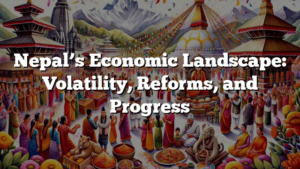
Good news for Nepal’s farming community and agro-based businesses! Meteorologists from South Asia are forecasting above-normal monsoon rainfall for most parts of the region, including Nepal. This prediction has raised hopes for a bountiful harvest, potentially reviving the country’s farm-dependent economy.
According to a statement released by the 28th Session of the South Asian Climate Outlook Forum on April 29, the monsoon season in South Asia is expected to bring above-normal rainfall to most areas, with only some northern, eastern, and northeastern parts likely to experience below-normal rainfall.
“A normal or above-normal monsoon is a blessing for our agricultural sector,” said Hem Raj Regmi, deputy chief statistician at the National Statistics Office. “It translates into a bountiful harvest, which boosts rural incomes and consumer spending.”
For Nepal, the monsoon is a crucial macroeconomic event, closely monitored by investors, the government, and consumers due to its significant impact on the economy. Agriculture accounts for nearly 25 percent of Nepal’s GDP and employs over 60 percent of the population, making the monsoon a critical factor for the country’s economic well-being.
Agro experts believe that an above-normal monsoon can accelerate crop transplantation, leading to higher yields. Increased production typically lowers food inflation due to the demand-supply mechanism in the market.
“The monsoon also helps recharge groundwater levels, water reservoirs, and rivers, which are vital for power generation,” added Regmi.
Sunil Pokharel, spokesperson at the Meteorological Forecasting Division, emphasized the importance of a well-distributed monsoon for the agricultural sector. However, he cautioned that excessive rainfall could also pose risks, such as landslides and floods, which are common natural hazards in Nepal during the monsoon season.
The normal monsoon onset and withdrawal dates for Nepal are June 13 and October 2, respectively. Last year, the monsoon entered eastern Nepal on June 14 and withdrew on October 15, with a 13-day delay.
With only a third of Nepal’s farms having year-round irrigation, the monsoon is crucial for the country’s Rs5.70-trillion economy, providing nearly 80 percent of the rain needed by farms.
This fiscal year, Nepal’s agriculture sector is projected to grow by 3.05 percent, according to the National Statistics Office, while the overall economy is expected to grow by 3.87 percent, heavily influenced by agricultural output.
Summer crops, particularly paddy (rice), are the primary income source for more than half of Nepal’s population. Paddy alone accounts for 5 percent of Nepal’s GDP, according to Regmi.
Last year, despite the El Niño phenomenon, Nepali farmers harvested a record 5.72 million tonnes of paddy, up 4.33 percent from the previous year, as per the Ministry of Agriculture and Livestock Development statistics.
This year, South Asian meteorologists predict a strong consensus among experts that La Niña conditions are likely to develop over the equatorial Pacific during the second half of the southwest monsoon season. La Niña conditions are generally associated with normal to above-normal southwest monsoon rainfall over most parts of South Asia.
As Nepal’s farm-dependent economy eagerly awaits the monsoon, businesses and stakeholders in the agricultural sector are keeping a close watch on the weather patterns, hopeful for a prosperous season that could revive the country’s rural economy.
Related:



